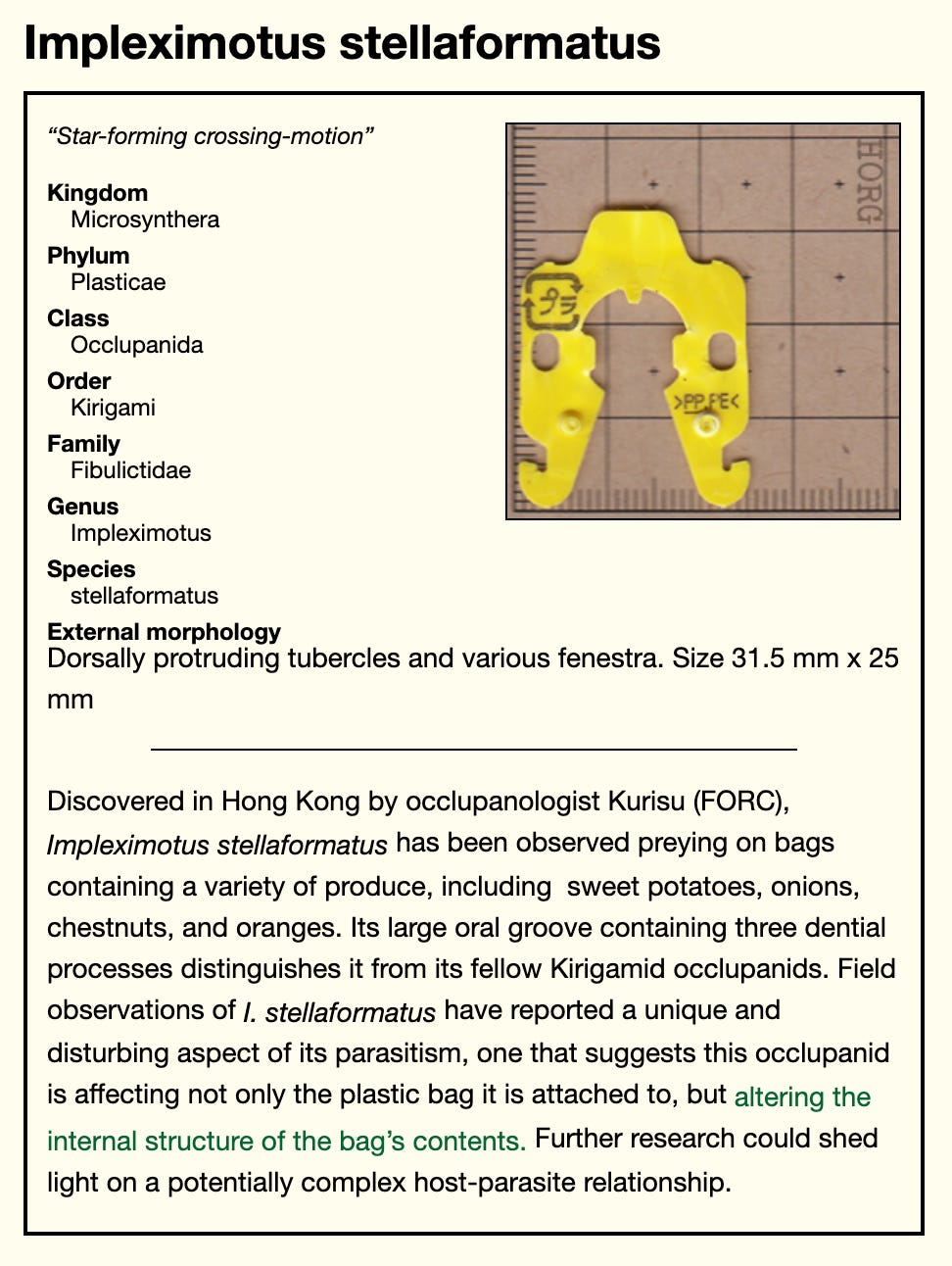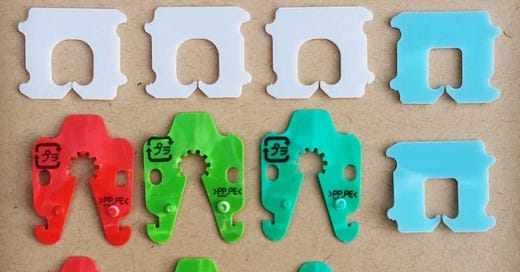Greetings Earthlings, 🖖
For this month’s edition of Cargo Manifest, I present to you, the occlupanid, a fine and handy specimen you’re quite familiar with.
You’ve seen them in supermarkets and have probably come across a few, abandoned on a quiet street in your town. And chances are, there is one in your home right now.
You’ve handled them over the course of your life and have thrown a bunch away, not knowing that there are people who treasure them, collect them, and study them. There’s a whole community who comes together to discuss and share stories about these fine creatures.
That’s right. I’m talking about bread clips aka bread tabs aka occlupanids - a member of the phylum Plasticae.
Occlupanid – Latin for “bread closer” (occlu “to close,” pan “bread”)
Look at them. Oh, the colors and variety!
Okay, before we get into bread clips…
You know, when people go all in on something they’re interested in? It can be about anything really, provided it’s ethical and doesn’t hurt anyone. Owl feathers, coffee roasting, the Olmec civilization, rocks, anything really. I just love it. That dedication, that drive, that seriousness, and attention to detail.
I know, they’re bread clips. Bread. Clips. But for real. Occlupanology is a thing and I’m sincerely fascinated. Embracing the weirdness. 🍞
“Where you find occlupanids,
there shallyou shall find civilization.”
– attributed to Horatio Horg
Thanks to a bag of peanuts 🥜
Let’s start with a bit of history.
Bread clips were invented by Floyd G. Paxton in the early 1950s.
Story has it, Paxton was on a plane with an opened bag of peanuts and needed to find a way to close it. So, he took out an expired credit card from his wallet and began to carve out a hand clip with a pen knife.
He later met a fruit packer from Pacific Fruit who needed a better way to close their new plastic bags packaging. At that point they were using rubber bands. And so Paxton introduced his clip, this time made from Pexiglas, and the rest is history.
The bread clip invented by Paxton is manufactured by Kwik Lock, which operates out of Yakima, Washington. They continue to be one of the biggest manufacturers of bread clips followed by Schutte, their European competitor.
Enter the wonderful world of occlupanids
And now, I present to you, the Holotypic Occlupanid Research Group (HORG) a nonprofit organization that has been at the forefront of classifying this common yet mysterious specimen of the phylum Plasticae – the occlupanid.
If you go to the HORG website, you’ll be able to access a database of synthetic taxonomy of bread clips found all over the world.
When you visit their website, you’ll understand why I’m so fascinated by the occlupanid community. The entire feat of classifying bread clips is just impressive.
Let’s just say, Carl Linnaeus, the father of taxonomy, would be so proud.
Plus, the parasitoid angle is just too entertaining.
Taken from the HORG website:
”Occlupanids are generally found as parasitoids on bagged pastries in supermarkets, hardware stores, and other large commercial establishments. Their fascinating and complex life cycle is unfortunately severely under-researched. What is known is that they take nourishment from the plastic sacs that surround the bagged product, not the product itself, as was previously thought. Notable exceptions to this habit are those living off rubber bands and on analog watch hands.”
“Where you find occlupanids,
there shallyou shall find civilization.”
-attributed to Horatio Horg
For you budding occlupanologists, here’s the Occlupanid Identification Guide which may come in handy should you wish to identify the occlupanid you come across.
Alternatively, here’s a user friendly version of the Identification Guide compiled by a Reddit member, who I believe is also the founder of the Foundation for Occlupanid Research and Communication (FORC). Information in this guide was taken from the HORG website.
You might want to get a folder and insert these placards for labeling. I’m guessing one of those coin sleeves would work; the kind coin collectors use.
And now, please allow me to bring to your attention, three interesting examples from the HORG database.

Yes, the HORG is a parody site and the hobby itself may seem weird and funny, but you can’t ignore the dedication and contribution occlupanologists have provided to the bread clip community. I, for one, am sold!
The Occlupanid Community
There are a number of communities you can join. I gather it’s a small community, where everyone is essentially part of every group. I can be wrong of course. If you’re interested, here are some links. By the way, I’ve just joined FORC’s Discord.
Contact HORG
If you come across an interesting bread clip, you can share it with HORG. They’re always looking for new specimens.
From their website:
”If you have found an occlupanid in a unique location, or discovered a new biome of an existing species, please let us know! We are also especially on the lookout for rare occlupanids of any species of the following families: Acutignathidae, Angulognathidae, Concavigulidae, Kamptoconidae, Odontotrochidae, and the Spinosacculidae.”
Bread Clip Art
And since we’re talking bread clips, Shani Nottingham is a multidisciplinary artist who spearheads The Breadtag Project – a long term art/environmental/awareness program that uses bread tags as a creative medium.
I believe Shani Nottingham has one of the biggest occlupanid collections in the world because people from all over the world donate bread clips to her for her artwork.
To discover Shani’s work, here’s her website, Instagram, and Facebook page.
Alright. That’s all for this edition of Cargo Manifest. I hope you enjoyed reading about occlupanids.
And if you stumble across an interesting looking specimen, do consider sharing it with HORG. It would make many occlupanologists and bread clip enthusiasts very happy.
Until next time! 🖖








